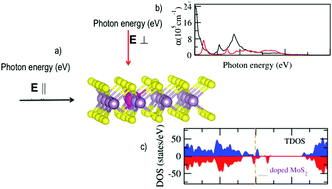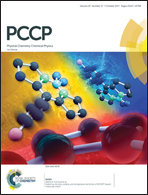Controlling the magnetic and optical responses of a MoS2 monolayer by lanthanide substitutional doping: a first-principles study†
Abstract
The electronic, magnetic and optical properties of lanthanide substitutional doping (∼2% concentration) on the MoS2 monolayer have been investigated within the density functional theory formalism together with the Hubbard correction (DFT+U). The dopants investigated include Ce, Eu, Gd, Lu and Tm. The calculated dopant substitutional energies under both Mo-rich and S-rich conditions suggest that it is possible to experimentally realize the lanthanide doped MoS2 monolayer systems. The Eu, Gd and Tm dopants induce strong magnetization in the host lattice. The electronic structure calculations reveal that the dopants have a p-type character and they exhibit a half-metallic behavior in the Gd and Eu doped systems. A dilute magnetic semiconducting behavior can also be realized in Gd, Eu and Tm doped systems by slightly tuning the Fermi level. All the dopants refine the optical responses of the host system with the onset of the optical absorption edge shifting to lower energies within the visible range (red shift phenomenon). We observe an optical anisotropy for two different directions of the electric field (E) polarizations, i.e. parallel, E∥, and perpendicular, E⊥, to the xy-plane. Lanthanide substitutional doping significantly influences the electron energy loss spectra (EELS), absorption spectra, and dielectric properties of the host MoS2 monolayer. Furthermore, we notice that lanthanide substitutional doping could enhance the photocatalytic properties of the MoS2 monolayer.



 Please wait while we load your content...
Please wait while we load your content...